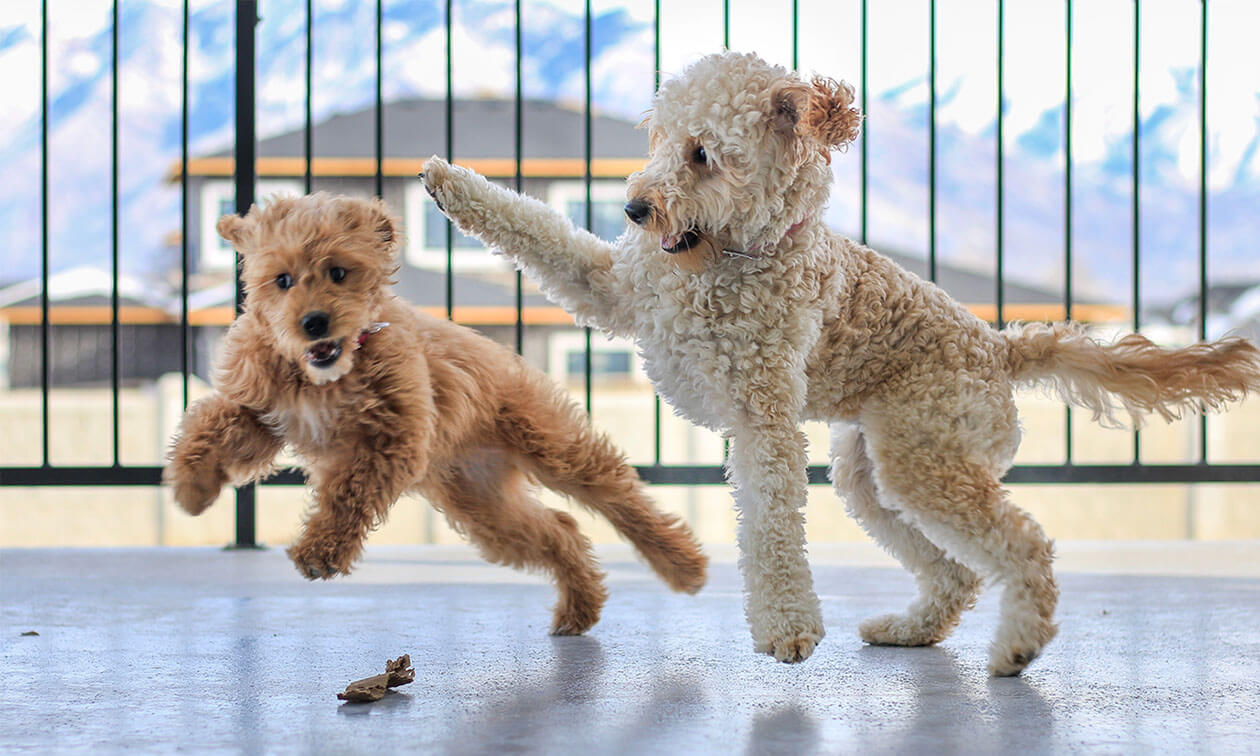Veterinarians and dog trainers are often asked about "designer" dog breeds — a term used to describe the crossbreeding of two purebred dogs. Some popular mixed breeds, also known as designer dog breeds, include Goldendoodles, Labradoodles, Goldadors, Puggles, American Corgis, Cowboy Corgis, Maltipoos, Cavapoos, Schnoodles, Pomskys, Cavachons, and many more.
While designer dogs have gained popularity in recent years, having a balanced perspective on these popular dogs is important. Let's explore the benefits of designer dog breed mixes while shedding light on some concerns raised by breeders, dog trainers, and veterinarians.
Are Designer Dogs Purebred?
Despite their name, designer breeds (sometimes referred to as hybrid or mixed breed dogs) are not purebred dogs. Purebred dogs are selectively developed over generations to have specific traits, like appearance, temperament, and working abilities. Purebred dogs are only bred to those of the same breed to get this result and have documentation of generations of distinct heritage.
Currently, designer dogs don’t have the same level of consistency among puppies that is required for purebred status. However, there is a movement towards recognition of the Australian Labradoodle with national kennel clubs, but the effort is still ongoing.
The Appeal of Designer Dog Breeds
Designer dog breeds offer a unique combination of traits from their parent breeds. This diversity can lead to various advantages that dog owners may find appealing.
Coat
The biggest appeal of a designer dog breed is often the resulting coat type, as many people are looking for a hypoallergenic or low-shedding dog breed. While no pet is truly hypoallergenic, these breeds tend to produce fewer allergens than others, which can lead to less allergic reactivity in people. This is why many designer dog breeds are crossed with Poodles.
Health
Another common argument for crossing two purebred dogs is hybrid vigor. By crossing two purebred dogs, the reasoning is that designer dogs may exhibit improved health, reduced genetic issues, and potentially increased longevity compared to some purebred counterparts.
Appearance
Designer dog breeds have exploded in popularity primarily due to the physical looks of the breed mixes. It's hard to resist a dog that has special coloring or characteristics that increase their cuteness factor.
Temperament and Behavior of Designer Dogs
Designer dog breeds can inherit a combination of temperament traits from their parent breeds. The extensive variety of designer dogs ensures there is a mix to suit almost any preference. For example, the Labradoodle, a cross between a Labrador Retriever and a Poodle, often inherits the intelligence and trainability of the Poodle alongside the friendly nature of Labradors.
While certain traits may be predictable within individual breeds, each designer dog is an individual, and their personality is also influenced by much more than genetics, such as environmental factors and early socialization. There are no guarantees for behavior.
Health and Longevity Considerations
Selective crossbreeding of designer dogs has the potential to reduce the incidence of certain genetic health issues that may be common in purebreds — the hybrid vigor argument. For instance, some designer dogs may be less prone to conditions such as hip dysplasia, which is prevalent in certain purebred lines.
Additionally, designer dog breeds may benefit from a larger gene pool, potentially resulting in better overall health and increased longevity. Designer dog breeders are also responsible for screening their dogs and puppies for health issues. Unfortunately, many of these breeders are only focused on the profit they can make in selling in-demand mixed breeds. Many will not invest in the needed health testing before a breeding.
It is crucial for prospective owners to research both parent breeds to understand any potential health concerns a designer breed may inherit.
The Controversy Surrounding Designer Dog Breeds
Even though designer dog breeds may have a lot of desirable traits, professionals such as veterinarians and breeders have concerns about these hybrid dogs.
Inconsistencies
One primary issue is inconsistent characteristics within the same breed. Unlike purebreds with standard traits, designer dogs can exhibit a wide range of variations due to genetic diversity from their parent breeds. This unpredictability can make it challenging for designer dog breeders to produce consistent litters and raises concerns about the reliability of certain breed characteristics. For example, you could be looking for a certain temperament or coat characteristic, but with a mixed breed there is no guarantee in the consistency of traits of the puppies. Their size, temperament, coat type, and color can vary widely.
Choosing the Right Dog for You
Approach designer dog breeds with caution, taking into consideration the concerns raised by professionals in the industry. From the inconsistency in characteristics to the presence of puppy mills, it is vital that dog owners are informed and conscientious of where they get their dog. By thoroughly researching breeders, understanding the parent breeds, and prioritizing the dog's well-being, prospective owners can make a more educated decision that aligns with their desires and supports responsible breeding practices.
Remember, whether you choose a purebred, designer dog breed, or rescue dog, what truly matters is the love, care, and commitment you provide to your four-legged family member.
ZPC-04247



